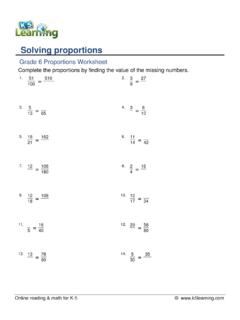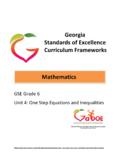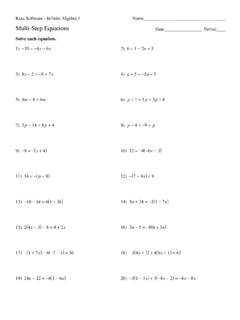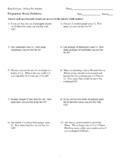Transcription of UNITED STATES - OECD
1 UNITED STATES Key issues Larger proportions of adults in the UNITED STATES than in other countries have poor literacy and numeracy skills, and the proportion of adults with poor skills in problem solving in technology-rich environments is slightly larger than the average, despite the relatively high educational attainment among adults in the UNITED STATES . Socio-economic economic background has a stronger impact on adult literacy skills in the UNITED STATES than in other countries. Black and Hispanic adults are substantially over-represented in the low-skilled population. Literacy skills are linked not only to employment outcomes, but also to personal and social well-being. In the UNITED STATES , the odds of being in poor health are four times greater for low-skilled adults than for those with the highest proficiency double the average across participating countries.
2 The survey The Survey of Adult Skills (PIAAC) provides a picture of adults proficiency in three key information-processing skills: literacy the ability of understand and respond appropriately to written texts; numeracy the ability to use numerical and mathematical concepts; and problem solving in information-rich environments the capacity to access, interpret and analyse information found, transformed and communicated in digital environments. Proficiency is described in terms of a scale of 500 points divided into levels. Each level summarizes what a person with a particular score can do. In literacy and numeracy there are five proficiency levels and problem solving there are three. The survey also provides a rich array of information regarding respondents use of skills at work and in everyday life, their education, their linguistic and social backgrounds, their participation in the labor market and other aspects of their well-being.
3 The Survey of Adult Skills was conducted in the UNITED STATES from 1 August 2011 to 31 March 2012. Some 5010 adults aged 16 to 65 were surveyed in the UNITED STATES . UNITED STATES Country Note Survey of Adult Skills - First results OECD 2 Time for the US to Reskill: What the Survey of Adult Skills Says Alongside the publication of the results from the Survey of Adult Skills, the OECD will publish a special report on the entitled, Time for the US to Reskill: What the Survey of Adult Skills Says, at the request of OVAE in the Department of Education. The report describes the main findings of the Survey of Adult Skills for the UNITED STATES and compares them with the results from a set of key comparison countries. The implications of the results in terms of labor market outcomes, such as employment and wages, and social outcomes, such as health and citizenship, are considered.
4 Potential explanations for the results are then assessed in relation to outcomes of basic schooling, age factors and educational attainment. Low-skilled adults are discussed in depth. The report also assesses the policy implications of the results and tenders policy recommendations. This country note draws on results published in the report. For more information on the report, see OECD (2013), Time for the to Reskill? : What the Survey of Adult Skills Says, OECD Skills Studies, OECD Publishing. Note: Figures in this country note compare the UNITED STATES with the average across participating countries and a set of key comparison countries.. performance is weak in literacy, very poor in numeracy, but only slightly below average in problem solving in technology-rich environments. In literacy, 12% of US adults score at the highest levels (Level 4/5) close to the average across participating countries, but a smaller proportion than in Finland and Japan (about 22%).
5 At Level 4, adults can integrate, interpret and synthesize information from complex or lengthy texts that contain conditional and/or competing information (for more details on what adults can do at each proficiency level, see the table at the end of this note). Meanwhile, one in six adults in the UNITED STATES scores below Level 2, in literacy a larger-than-average proportion compared with one in 20 adults who score at this level in Japan. The average literacy score among adults in the US (270 points, which corresponds to proficiency Level 2) is similar to that in Germany and England/Northern Ireland (UK). This score is higher than the average in France, Italy, Poland and Spain, but lower than that in Australia, Canada and Japan. About one in three (34%) adults scores at Level 3 in literacy, and one in three (33%) attains Level 2. In numeracy, only 8% of adults score at Level 4/5, below the average of 13%.
6 By contrast, 19% of adults in Japan and Finland achieve the highest levels of proficiency. At the other end of the performance spectrum, nearly one in three adults in the UNITED STATES scores below Level 2 in numeracy. The average score in the UNITED STATES (253 points, corresponding to Level 2) is higher than that in only two comparison countries (Italy and Spain) and similar to that in France. One in four adults (26%) scores at Level 3 and one in three adults (33%) scores at Level 2. In problem solving in technology-rich environments, nearly one in three adults (31%) score at least at Level 2, slightly below the average across all participating countries (34%) and close to Korea s average (30%). The Netherlands and Finland are among the top performers in this domain, with about 42% of adults performing at Level 2 and above. Around one in three adults in the UNITED STATES scores at Level 1 proficiency. The remaining one third is evenly divided between those who score lower than Level 1 in problem solving and those who were unable to display any skills in this domain.
7 UNITED STATES Country Note Survey of Adult Skills - First results OECD 3 Literacy proficiency among adults Percentage of adults scoring at each proficiency level in literacy How to read this chart: This chart shows the share of adults at different levels of literacy proficiency. For example, in the UNITED STATES of adults scored at Level 3 and of adults scored at Level 4/5. Countries closer to the top of the chart have proportionately more adults who score at higher levels of literacy. The black bar on the left edge of the chart shows the share of adults for whom no literacy score was imputed. Notes: Countries are ranked in descending order of the combined percentage of adults scoring at Level 3 and Level 4 or 5. Adults in the missing category were not able to provide enough background information to impute proficiency scores because of language difficulties, or learning or mental disabilities (referred to as literacy-related non-response).
8 Source: Survey of Adult Skills (PIAAC) (2012). StatLink 2 StatesGermanyEngland/N. Ireland (UK)KoreaAverageCanadaAustraliaNetherlan dsFinlandJapanPercentMissingBelow Level 1 Level 1 Level 2 Level 3 Level 4/5 UNITED STATES Country Note Survey of Adult Skills - First results OECD 4 Numeracy proficiency among adults Percentage of adults scoring at each proficiency level in numeracy How to read this chart: This chart shows the share of adults at different levels of numeracy proficiency. For example, in the UNITED STATES of adults scored at Level 3 and of adults scored at Level 4/5. Countries closer to the top of the chart have proportionately more adults who score at higher levels of numeracy. The black bar on the left edge of the chart shows the share of adults for whom no numeracy score was computed. Notes: Countries are ranked in descending order of the combined percentage of adults scoring at Level 3 and Level 4 or 5.
9 Adults in the missing category were not able to provide enough background information to impute proficiency scores because of language difficulties, or learning or mental disabilities (referred to as literacy-related non-response). Source: Survey of Adult Skills (PIAAC) (2012). StatLink 2 StatesFrancePolandEngland/N. Ireland (UK)KoreaCanadaAustraliaAverageGermanyNe therlandsFinlandJapanPercentMissingBelow Level 1 Level 1 Level 2 Level 3 Level 4/5 UNITED STATES Country Note Survey of Adult Skills - First results OECD 5 Proficiency in problem solving in technology-rich environments among adults Percentage of adults scoring at each proficiency level in problem solving in technology-rich environments How to read this chart: This chart shows the share of adults at different levels of proficiency in problem solving in technology-rich environments. For example, in the UNITED STATES 26% of adults scored at Level 2 and of adults scored at Level 3.
10 Countries closer to the top of the chart have proportionately more adults who score at higher levels of skills. The black bar on the left edge of the chart shows the share of adults for whom no proficiency score was computed. Notes: Adults included in the missing category were not able to provide enough background information to impute proficiency scores because of language difficulties, or learning or mental disabilities (referred to as literacy-related non-response). The missing category also includes adults who could not complete the assessment of problem solving in technology-rich environments because of technical problems with the computer used for the survey. France, Italy and Spain did not participate in the problem solving in technology-rich environments assessment. Countries are ranked in descending order of the percentage of adults who scored at Level 2 or 3.















